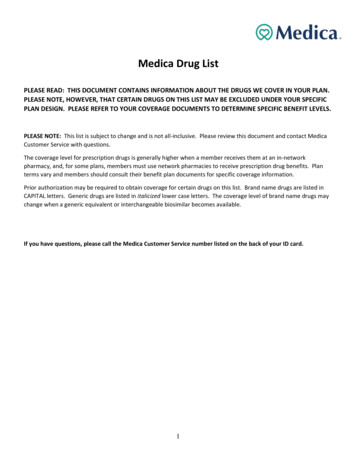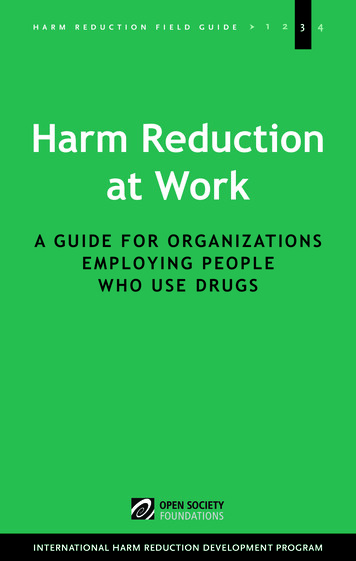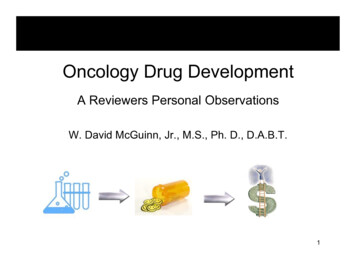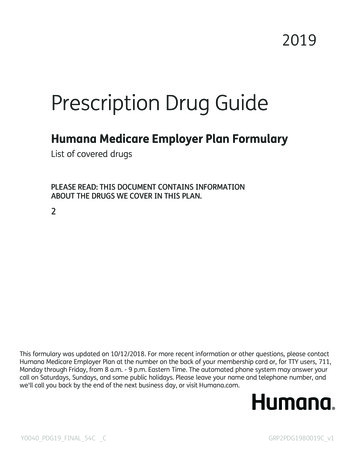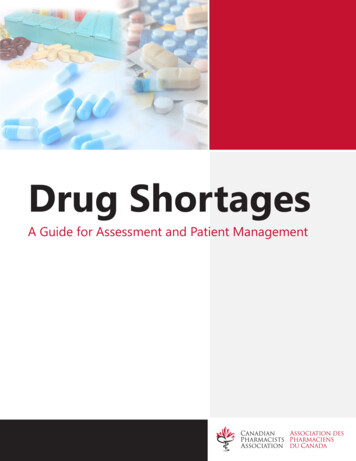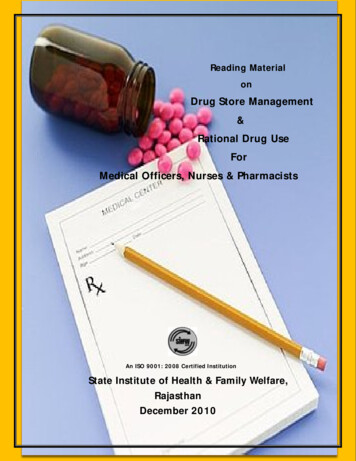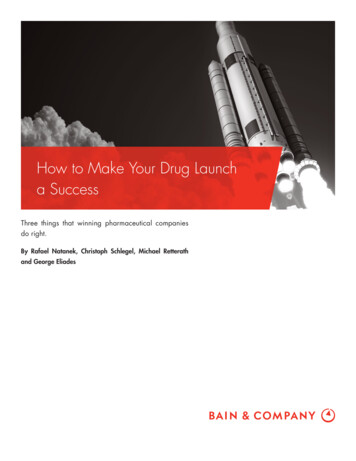
Transcription
How to Make Your Drug Launcha SuccessThree things that winning pharmaceutical companiesdo right.By Rafael Natanek, Christoph Schlegel, Michael Retterathand George Eliades
Rafael Natanek is a partner with Bain & Company in the London office, Christoph Schlegel is a Bain partner in the Frankfurt office, Michael Retterath is aBain partner in the New York office and George Eliades is a partner with Bainin the San Francisco office.The authors wish to give special thanks to Gilbert Grima, Nathalie FetzerHoernig, Anna Boleininger, Will Menz, Nicole Sinclair and Giovanni Mianifor their contributions to this report. Additional thanks to Gail Edmondsonfor her editorial support.Net Promoter , Net Promoter System , Net Promoter Score and NPS are registered trademarks of Bain &Company, Inc., Fred Reichheld and Satmetrix Systems, Inc.Copyright 2017 Bain & Company, Inc. All rights reserved.
How to Make Your Drug Launch a SuccessOur findings show that companies with successfullaunches do three things right:The pain is becoming all too common for manypharmaceutical executives. After a decade or more ofinvestment in drug development and clinical trials, acompany launches a promising new product only to seesales fall far short of expectations. Our research showsthat nearly 50% of launches over the past eight yearshave underperformed analyst expectations, and morethan 25% have failed to reach even 50% of external revenue forecasts.That’s a serious concern for the pharma industry, whichis expected to derive 25% to 80% of its revenue fromnew launches by 2021. While the level of clinical differentiation plays an important role in a drug’s success,there are many examples of successful drugs that werenot considered a major clinical breakthrough at launch,such as Bayer’s and Johnson & Johnson’s Xarelto. Tounderstand how success factors that are within the control of a launch team are changing, we surveyed 100senior launch executives from the top 20 pharmaceuticalcompanies. The Bain & Company study examined theperformance of each launch across 20 launch activities. They differentiate their drug through messaging,postlaunch data and services. They create broad customer advocacy via a superior customer experience. They organize their launch as a micro-battle andensure continuous frontline feedback.Other factors, such as comprehensive market research,key opinion leader advocacy and competitive resourcing—all important for a successful launch—do not ensure outperformance (see Figure 1). Our research also showsthat executives significantly underestimate several keysuccess factors, including customer advocacy and organizing the launch as a micro-battle. And while theyunderstand the importance of messaging, postlaunchdata and services, they often fail to effectively communicate their market research to payers and providers.Figure 1: Many senior launch executives overlook important success factorsOverrated success factorsPerceived importance40%Recognized differentiatorsInsights-based messagingKey opinion leader advocacy30Postlaunch dataand services20Market researchMicro-battleapproachPhysicianadvocacyPayer advocacy andprotocol shaping10Salesforcefeedback andengagementShare of voiceBare minimum0024Underrated differentiators68101214%Difference between overperformers and underperformersDifferentiation beyond phase III dataCustomer advocacyCompany readinessNotes: Comprehensive market research includes physician segmentation, patient journeys, and unmet patient and payer needs; perceived importance is the percentage of seniorexecutives who consider activity among top four most important for launch success; difference between overperformers and underperformers is the absolute difference in launchactivity performance (100% best practice performance); share of voice is the share of total available time in which a target audience is captured with a focused message; amicro-battle approach includes teaming and frontline mobilizationSource: Bain 2017 launch survey (n 100 senior executives from top 20 pharmaceutical companies)1
How to Make Your Drug Launch a SuccessGo beyond clinical trial results to make your pared with twice-daily for Boehringer Ingelheim’s firstto-market rival drug Pradaxa.product stand outA second important success factor is conducting postlaunch studies to close any remaining gaps in data andensure superior data quality over competing productsand new entrants. High-quality data, in turn, enhancesmarket access. Successful companies put a postlaunchevidence-generation plan in place 18 months beforethe launch to generate a steady stream of data after thelaunch that supports the drug’s efficacy. Take the example of Celgene, which produced almost twice asmany postlaunch studies in Europe for its multiplemyeloma drug Revlimid as compared with its closestcompetitor. Celgene’s steady drumbeat of fresh evidence has given Revlimid a competitive advantage bykeeping it at the forefront of hematologists’ minds.New drug launches face more intense competition today than they faced a decade ago. The average windowof time in which a drug remains on the market beforecompeting products arrive has fallen to four years,down from eight years between 2000 and 2004. Theonslaught of new products makes it much harder to usephase III clinical trial data alone to differentiate a drugin the eyes of doctors, regulators and health insurers.Companies with launches that repeatedly outperformexpectations are adept at communicating the key clinical and nonclinical benefits of a new product to prescribing physicians and other decision makers. Oftenthey also use postlaunch data and services to furtherdifferentiate their product from the competition.Third, successful companies increase the effectivenessof their messaging by including a competitive serviceoffer to address patient and physician pain points—a factor many pharma executives overlook or undervalue. Physician services, such as diagnostics, patientidentification, onboarding, reimbursement supportand compliance, play a significant role in successfullaunches. During the recent launch of a neurology drugby a top pharma company, for example, the launchteam noted that the administrative burden of gettingpatients started on therapy was a crucial pain point. Inresponse, the team invested far beyond the initial planto relieve the burden.Most senior executives understand that effective marketing messaging is critical to launch success. But getting it right is not easy. Our survey and experienceshow a large gap between winners and losers.Companies with the most effective messaging followthree key guidelines. First, they translate research intoactionable insights. All the companies we surveyedsaid they use market research tools, including patientpathways, physician segmentation and focus groups.However, only those with successful launches transformed market data into actionable insights to maketheir product stand out. These messages are groundedin clinical data and built on efficacy and safety, but theyalso take into consideration the cognitive shortcutsdoctors deploy when they learn about new treatmentsand make decisions (heuristics). Understanding thesepathways can help pharma companies communicatethe benefits of their medicines more effectively.Build customer advocacy through superiorcustomer experiencePhysicians today consider a much wider set of factorsbeyond clinical data when deciding which drug to prescribe, including clinical protocols, drug price, the typeof patient to whom a drug can be prescribed and overall treatment regimen. And they are rapidly shifting toa broader array of information sources, especially online sites and peers.Bayer’s successful launch of its anticoagulant drugXarelto highlights the power of effective messaging.Even though Xarelto was second to market and manystakeholders did not consider it the most effectivecompound in its class at the time of launch, it rapidlybecame a market leader. Xarelto used simplicity as adifferentiation factor: It offered once-a-day dosing com-Our research shows that at least 40% of physicians’brand preference is attributable to customer experience factors beyond the product, including, for exam2
How to Make Your Drug Launch a SuccessFigure 2: Transforming a drug launch into a micro-battleTraditional launch approachLaunch as a micro-battleHead of launch reports to medical marketingHead of launch team reports to CEO90% of work takes place in functional silosLaunch team empowered to workacross functionsFunctions control launch budgetHead of launch team controls budgetTeam focused on functional check listsTeam focused on strategic issuesRapid approach to work: test, adapt,Linear approach to worklearn and scaleSources: Bain experience; executive interviewsple, how well pharma companies support physiciansby providing answers to medical questions, identifyingpatients and connecting physicians with peers.son contacts within 24 hours of the physician’s request.Our study showed some of these interactions have agreater impact on prescribing behavior than others.Many pharma companies, however, focus their advocacy activities on the most influential physicians in agiven field—the key opinion leaders—and miss the opportunity to create advocates among the day-to-day prescribers. Bain research shows physicians give pharmacompanies an average Net Promoter Score of negative 11% across all their interactions with them. Thatnegative score highlights the significant potential toincrease launch success by designing and delivering asuperior customer experience to physicians.Organize your launch as a micro-battleNew drug launches today require greater coordinationacross the entire organization, including market access,patient services, medical affairs, regulatory, marketingand sales. Many pharma companies continue to rely onloosely organized cross-functional teams with a nominal global leader. The problem with that approach isthat functional silos control the power, budget and talent decisions. And silo leaders manage drug launchesvia checklist, a rote approach that undercuts the group’sability to raise or respond to critical issues and makecross-functional decisions.Leading companies look beyond the key opinion leaders and turn day-to-day prescribers into advocates byproviding them with a superior customer experience.They understand that a physician’s overall customerexperience is a sum of individual interactions with apharma company. Every interaction or episode is anopportunity to engage in a positive dialogue. One example is providing easy and accurate medical science liai-Companies that outperform organize drug launchesinto micro-battles (see Figure 2). They create a company within the company, giving launch teams the authority and agility to make decisions that are best forthe patient or the brand. Importantly, a micro-battle3
How to Make Your Drug Launch a SuccessBut my launch is differentapproach allows launch teams to focus on strategic issues for the success of the launch, not for checklists.Working with different scenarios instead of staticmarket insights and a linear launch plan, they lookout far beyond the launch date.Pharma companies that repeatedly outperform expectations for new product launches develop new sourcesof differentiation, focus on building superior customerexperiences and treat drug launches as a micro-battle.Of course, where exactly a company invests within thesethree areas will differ, depending on clinical superiority and category leadership in a given field. An effective strategy is tailored to these two important factors.Pharma companies that approach the drug launch asa micro-battle move quicker, make bolder decisionsand achieve superior launch results. They are moreflexible and adapt rapidly to competitors, regulatorychanges or new insights. Our data highlights this important shift: The most consistently undervalued factorcontributing to a successful launch is the way leadership teams organize and manage the launch process.Leadership teams interested in benchmarking theirlaunch results against this powerful approach can startby posing the following questions:How does a micro-battle strategy work? The first stepis assembling the right cross-functional team—namely,10 to 20 high-potential individuals who report to alaunch CEO. The launch CEO is a senior executivewho owns the micro-battle results and reports directlyto the company CEO. These teams, which can includemarketing and medical brand leaders as well as supplyand commercial leaders from core countries, collectcustomer feedback before, during and after the launch,and make rapid adjustments as needed to the launchstrategy. The launch CEO has decision rights or at leaststrong recommendation rights on strategy, resourcingand staffing decisions for the brand. Leadership teamssupport the micro-battle, affirming decisions, removingroadblocks, securing resourcing and coaching.4 How did our last three launches perform vs. expectations, and what were the reasons for underperformance or overperformance? Have we identified all potential differentiationareas of our drug and incorporated them into ourmessaging? Which interactions matter most for our targetphysicians, and do we provide a superior customerexperience? What are the three largest internal challenges thelaunch team faces, and what would it take to eliminate them?
Shared Ambit ion, True ResultsBain & Company is the management consulting firm that the world’s business leaders cometo when they want results.Bain advises clients on strategy, operations, technology, organization, private equity and mergers and acquisitions.We develop practical, customized insights that clients act on and transfer skills that make change stick. Foundedin 1973, Bain has 55 offices in 36 countries, and our deep expertise and client roster cross every industryand economic sector. Our clients have outperformed the stock market 4 to 1.What sets us apartWe believe a consulting firm should be more than an adviser. So we put ourselves in our clients’ shoes, sellingoutcomes, not projects. We align our incentives with our clients’ by linking our fees to their results and collaborateto unlock the full potential of their business. Our Results Delivery process builds our clients’ capabilities, andour True North values mean we do the right thing for our clients, people and communities—always.
Key contacts in Bain’s Healthcare practiceAmericasGeorge Eliades in San Francisco (george.eliades@bain.com)Michael Retterath in New York (michael.retterath@bain.com)Asia-PacificVikram Kapur in Hong Kong (vikram.kapur@bain.com)Europe,Middle Eastand AfricaRafael Natanek in London (rafael.natanek@bain.com)Christoph Schlegel in Frankfurt (christoph.schlegel@bain.com)For more information, visit www.bain.com
success factors, including customer advocacy and orga-nizing the launch as a micro-battle. And while they understand the importance of messaging, postlaunch data and services, they often fail to effectively commu-nicate their market research to payers and providers. Figure 1: Many senior launch executives overlook important success factors 0 10 .

